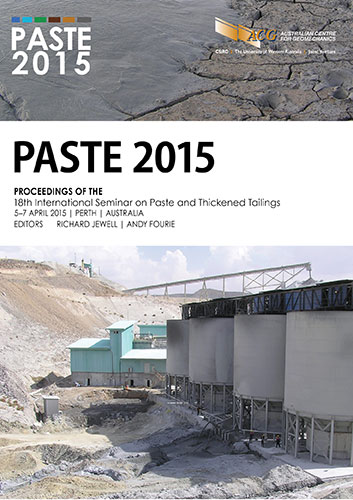Dewatering in a laboratory simulation of a multilayer deposit of inline flocculated mature fine tailings

|
Authors: Rozina, E; Mizani, S; Malek, M; Sanchez-Sardon, M; Simms, P |
DOI https://doi.org/10.36487/ACG_rep/1504_04_Mizani
Cite As:
Rozina, E, Mizani, S, Malek, M, Sanchez-Sardon, M & Simms, P 2015, 'Dewatering in a laboratory simulation of a multilayer deposit of inline flocculated mature fine tailings', in R Jewell & AB Fourie (eds), Paste 2015: Proceedings of the 18th International Seminar on Paste and Thickened Tailings, Australian Centre for Geomechanics, Perth, pp. 81-93, https://doi.org/10.36487/ACG_rep/1504_04_Mizani
Abstract:
This paper examines the dewatering behaviour of in-line flocculated oil sand mature fine tailings. Tailings used in this study had an initial solids concentration of 36% and were dosed at 650 g/t, using laboratory procedures that have previously been shown to represent field mixing conditions. Three layers of initial thicknesses of 0.3 to 0.35 m were successively placed in an instrumented box 0.7 by 1 m in plan, mounted on scales and equipped with a drainage system. Water content sensors and porewater pressure sensors were placed at various heights. Volume change was tracked by non-contact displacement sensors and by time-lapse imaging and hand measurement of crack development. Increases in evaporation were found to be strongly correlated with the appearance of cracks. The actual evaporation rate exceeded the potential evaporation rate as long as crack development continued to occur. This is the first documented case of evaporation exceeding the potential rate in any controlled laboratory study. Despite substantial drainage, supernatant water formed on top of the tailings, and remained there longer than the initial consolidation phase of dewatering. Consolidation alone was able to increase solids concentration of the tailings to about 53%. For these tailings, which show a relatively high shear strength (achieving the directive 74 requirement between 55 and 60% solids, if porewater pressure is near zero or negative), not much drying is required to bring the tailings to regulatory compliance; even less is required if the tailings consolidate further when buried by new layers. Conservatively extrapolating the results of this test, it is estimated that a rate of rise of 2.2 m per year would still allow for the regulatory shear strength of 5 kPa to be achieved. This rate of rise is comparable to that proposed by field studies on similar tailings in thin lifts.
References:
Caldwell, J, Revington, A, McPhail, G & Charlebois, l 2014, ‘Optimized seasonal deposition for successful management of treated mature fine tailings’, in RJ Jewell, AB Fourie, PS Wells & D van Zyl (eds), Proceedings of the Eighteenth International Conference on Paste and Thickened Tailings, InfoMine Inc., Vancouver, pp. 1-18.
Daliri, F Simms, P & Sivathayalan, S 2012, ‘Contribution of desiccation to monotonic and cyclic strength of thickened gold tailings: not the same as over-consolidation’, in RJ Jewell, AB Fourie & A Paterson (eds), Proceedings of the Fifteenth International Seminar on Paste and Thickened Tailings, Australian Centre for Geomechanics, Perth, pp. 73-84.
Dunmola, A, Cote, C, Freeman, G, Kolstad D, Song, J & Masala, S 2013, ‘Dewatering and shear strength performance of in-line flocculated mature fine tailings under different depositional schemes’, in GW Wilson, DC Sego & NA Beier (eds), Proceedings of the Seventeenth International Conference on Tailings and Mine Waste, University of Alberta, Edmonton, pp. 5-14.
Fisseha, B, Bryan, R & Simms, P 2010, ‘Evaporation, unsaturated flow, and salt accumulation in multilayer deposits of “paste” gold tailings’, Journal of Geotechnical and Geoenvironmental Engineering, vol. 135, no. 12, pp. 1703-1712.
Fujiyasu, Y, Fahey, M & Newson, T 2000, ‘Field investigation of evaporation from freshwater tailings’, Journal of Geotechnical and Geoenvironmental Engineering, vol. 126, no. 6, pp. 556-567.
Innocent-Bernard, T, Simms, P, Sedgwick, A, Kaminsky, H & Yang, X 2013, ‘Influence of surface cracking and salinity on evaporation in an oil sands thickened tailings’, in GW Wilson, DC Sego & NA Beier (eds), Proceedings of the Seventeenth International Conference on Tailings and Mine Waste, University of Alberta, Edmonton.
Mizani, S, Soleimani, S, Simms, P 2013, ‘Effects of polymer dosage on dewaterability, rheology, and spreadability of polymer-amended mature fine tailings’, in RJ Jewell, AB Fourie, J Caldwell & J Pimenta (eds), Proceedings of the Sixteenth International Seminar on Paste and Thickened Tailings, Australian Centre for Geomechanics, Perth, pp. 117-131.
Scott, D, Kabwe, L & Wilson, W 2013, ‘Long term consolidation behaviour of the mature fine tailings MFT in the 30-years 10-m standpipe’, Proceedings of the Seventeenth International Conference on Tailings and Mine Waste, University of Alberta, Edmonton.
Soleimani, S, Simms, P Dunmola A, Freeman, G & Wilson, W 2014, ‘Desiccation and consolidation in thin-lift deposition of polymer amended MFT’, in RJ Jewell, AB Fourie & J Caldwell (eds), Proceedings of the Seventeenth International Seminar on Paste and Thickened Tailings, InfoMine Inc., Vancouver, pp. 75-86.
Simms, P, Daliri, F & Sivathayalan, S 2013, ‘Desiccation in dewatering and strength development of high-density hard rock tailings, in RJ Jewell, AB Fourie, J Caldwell & J Pimenta (eds), Proceedings of the Sixteenth International Seminar on Paste and Thickened Tailings, Australian Centre for Geomechanics, Perth, pp. 75-86.
Wells, PS, Revington, A & Omotoso, O 2011, ‘Mature fine tailings drying – technology update’, in RJ Jewell & AB Fourie (eds), Proceedings of the Fourteenth International Seminar on Paste and Thickened Tailings, Australian Centre for Geomechanics, Perth, pp. 155-166.
© Copyright 2025, Australian Centre for Geomechanics (ACG), The University of Western Australia. All rights reserved.
View copyright/legal information
Please direct any queries or error reports to repository-acg@uwa.edu.au
View copyright/legal information
Please direct any queries or error reports to repository-acg@uwa.edu.au